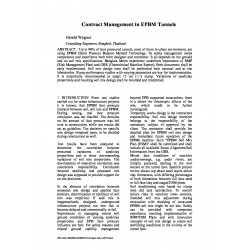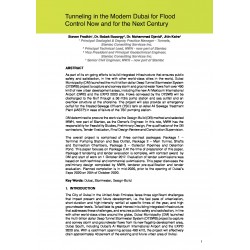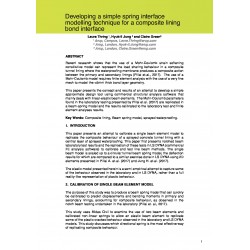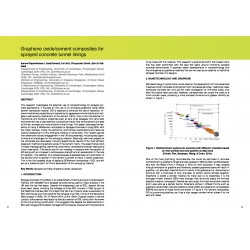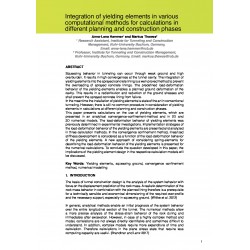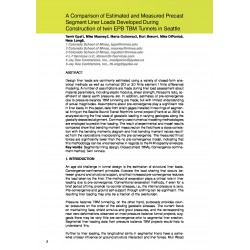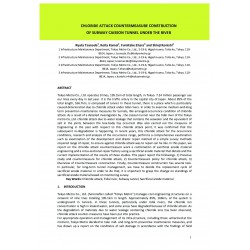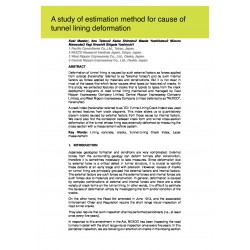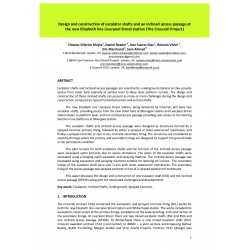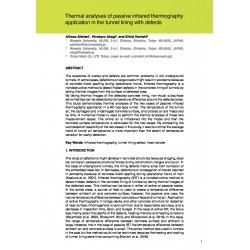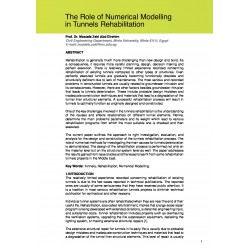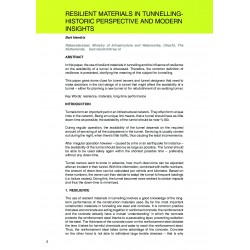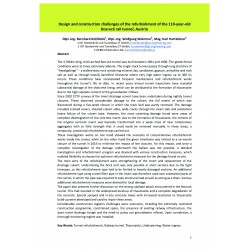No document
Search & filter
Search for a publication
Search & filter
Papers from WTC and ITA conferences have been made available as PDF documents.
ProceedingsThere are 1984 documents.
List of endorsed conferences
-
WTC
World Tunnelling Congress
-
Contract Management in EPBM Tunnels
Abstract: Up to 90% of face pressured tunnels, most of them in urban environment, are using EPBM (Earth Pressure Balance Method Technology. Its safety management needs competence and experience both from designer and contractor. It all depends on the ground and on soil mix specifications. Bangkok Metro experience underlines importance of RMP (Risk Management Plan) and GBR (Geotechnical Baseline Report)....
0,00 € -
Tunneling in the Modern Dubai for Flood Control Now and for the Next Century
Abstract: As part of its on-going efforts to build integrated infrastructure that ensures public safety and satisfaction, in line with other world-class cities in the world, Dubai Municipality (DM) launched the multi-billion dollar Deep Tunnel Stormwater System (DTSWS) project to capture and convey storm and ground water flows from over 490 km2 of new urban development areas, including the new Al Maktoum...
0,00 € -
Design of Sprayed Concrete Lined Shafts for Tideway Central Contract
Abstract: Tideway project is a new 25km long combined sewage storage and transfer system beneath the River Thames in Central London currently under design and construction. Three design and build contracts have been awarded. The contract for the central section, the biggest and most challenging one, consists of 12.7km of tunnel and 8 sites with deep inlet shafts and ancillary structures. A number of...
0,00 € -
Developing a simple spring interface modelling technique for a composite lining bond interface
Abstract: Recent research shows that the use of a Mohr-Coulomb strain softening constitutive model can represent the load sharing behaviour in a composite tunnel lining where the waterproofing membrane produces a composite action between the primary and secondary linings (Pillai et.al., 2017). The use of a Mohr-Coulomb model requires finite element analysis with the use of a very fine mesh to model the
0,00 € -
Graphene oxide/cement composites for sprayed concrete tunnel linings
Abstract: This research investigates the potential use of nanotechnology for sprayed concrete applications. It focuses on the use of an emerging graphene oxide (GO)/cement composite material. GO is reported to enhance the rate of hydration, improve mechanical properties and resistance to aggressive environments and instigate a self-sensing mechanism of the cement matrix. Due to the improvement in...
0,00 € -
Integration of yielding elements in various computational methods for calculations in different planning and...
Abstract: Squeezing behavior in tunneling can occur through weak ground and high overburden. It results in high convergences at the tunnel cavity. The integration of yielding elements into the sprayed concrete lining is a well-proved method to prevent the overloading of sprayed concrete linings. The predefined load-deformation behavior of the yielding elements enables a planned ground deformation of the...
0,00 € -
A Comparison of Estimated and Measured Precast Segment Liner Loads Developed During Construction of twin EPB TBM...
Abstract: Design liner loads are commonly estimated using a variety of closed-form analytical methods as well as numerical (2D or 3D fnite element / fnite difference) modeling. A number of assumptions are made during liner load assessment about material parameters, including elastic modulus, shear strength, Poisson’s ratio, coeffcient of lateral earth pressure, etc. In addition, estimates of...
0,00 € -
Chloride attack countermeasure construction of subway caisson tunnel under the river
Abstract: Tokyo Metro Co., Ltd. operates 9 lines, 195.1km of total length, in Tokyo. 7.24 million passenger use our lines every day in last year. It is the traffic artery in the capital city of Japan. About 85% of the total length, 166.7km, is composed of tunnel. In these tunnel, there is a place which is particularly caused deterioration due to chloride attack under tidal rivers. In order to examine...
0,00 € -
A study of estimation method for cause of tunnel lining deformation
Abstract: Deformation of tunnel lining is caused by such external factors as forces applied from outside (hereinafter referred to as “external forces”) and by such internal factors as forces applied by materials and constructions. But it is not clear in most of the cases that which factor causes what types (or features) of cracks. In this study, we extracted features of cracks that is typical to types...
0,00 € -
Design and construction of escalator shafts and an inclined access passage at the new Elizabeth line Liverpool Street...
Abstract: Escalator shafts and inclined access passages are essential for underground stations as they provide access from ticket halls typically at surface level to deep level platform tunnels. The design and construction of these inclined shafts can present as many or more challenges during the design and construction compared to typical horizontal tunnels and vertical shafts. The new Elizabeth line...
0,00 € -
Method for water inflow rate estimation from sample measurements of surface flows on tunnel walls
Abstract: Water inflow rate is an important factor in the assessment of tunnel conditions. Excessive water inflow could cause corrosion of metallic services, short circuiting of electrical devices and generally create a hazardous environment within the tunnel. A method for estimating the water inflow rate along a tunnel wall is developed by considering various crack and joint orientations and locations...
0,00 € -
Thermal analyses of passive infrared thermography application in the tunnel lining with defects
Abstract: The existence of cracks and defects are common problems in old underground tunnels. In some cases, defections or large cracks might result in accidents because of concrete block spalling during operational hours. Infrared thermography is a nondestructive method to detect hidden defects in the concrete lining of tunnels by taking thermal images from the surface of defected area.By taking thermal...
0,00 € -
The Role of Numerical Modelling in Tunnels Rehabilitation
Abstract: Rehabilitation is generally much more challenging than new design and build. As a consequence, it requires more careful planning, design, decision making and perfect execution. There is relatively limited experience recorded concerning rehabilitation of existing tunnels compared to other types of structures. Even perfectly executed tunnels are gradually becoming functionally obsolete and...
0,00 € -
Resilient materials in tunnelling historic perspective and modern insights
Abstract: In this paper, the use of resilient materials in tunnelling and the influence of resilience on the availability of a tunnel is discussed.
0,00 € -
Design and construction challenges of the refurbishment of the 110-year-old Bosruck rail tunnel, Austria
Abstract: The 4.766km-long, brick-arched Bosruck tunnel was built between 1901 and 1906. The geotechnical conditions were at times extremely adverse. The single-track tunnel passes through long stretches of “Haselgebirge” – a sedimentary rock containing mineral clay, sandstone, gypsum, anhydrite and rock salt as well as through heavily karstified limestone where very high water ingress up to 360 l/s...
0,00 € -
Properties of Acrylate Grouts and their Use in Tunnel for Waterproofing and Repair Jobs.
Abstract: Chemical grouts are injected into voids or cracks for several purposes such as waterproofing, consolidation, reinforcement and sealing. Unlike cement grouts which are suspensions of particles carried by a fluid especially used for void filling or reinforcement, chemical grouts are liquids that react to form a solid or a gel. Acrylate grouts are part of this chemical grouts family. They are...
0,00 €


